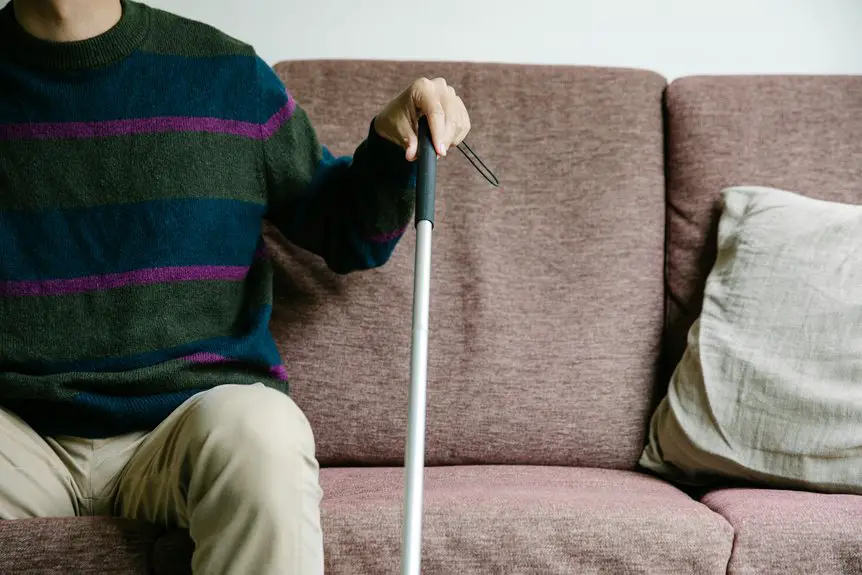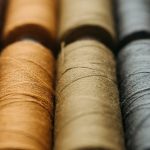Polypropylene fabric is a lightweight, durable material made from a thermoplastic polymer called polypropylene. It’s moisture-wicking, chemical-resistant, and great for insulation, making it perfect for activewear, medical gear, and outdoor products. You’ll find it in everything from reusable bags to thermal underwear because it dries quickly and resists stains. If you want to know how it’s made, its types, uses, and care tips, keep exploring to reveal all the details.
Table of Contents
Key Takeaways
- Polypropylene fabric is a lightweight, durable thermoplastic polymer made from propylene monomers with excellent moisture and chemical resistance.
- It features moisture-wicking properties, keeping users dry and comfortable by repelling water and drying quickly.
- The fabric exhibits strong abrasion resistance and maintains flexibility even in cold temperatures without becoming brittle.
- Polypropylene is used widely in medical disposables, activewear, automotive interiors, reusable bags, and home furnishings.
- Care involves washing in mild detergent, avoiding bleach, and air drying to preserve durability and performance.
Understanding Polypropylene: Basic Definition and Composition
Polypropylene is a versatile thermoplastic polymer made from propylene monomers. When you look at its basic composition, it’s a chain of carbon atoms bonded with hydrogen, forming a lightweight yet strong material.
Polypropylene: a lightweight, strong thermoplastic made from chains of carbon and hydrogen atoms.
You’ll find this polymer categorized as a polyolefin, which means it’s derived from simple olefin hydrocarbons. Its chemical structure gives it excellent resistance to moisture, chemicals, and fatigue, making it perfect for various applications.
When you work with polypropylene, you’ll notice it’s flexible but holds its shape well, thanks to its semi-crystalline nature. This unique combination of properties comes from how the polymer chains are arranged, providing durability without adding much weight.
Understanding this foundation helps you appreciate why polypropylene fabric is so widely used.
The Manufacturing Process of Polypropylene Fabric
You’ll start by melting polypropylene pellets through polymer extrusion techniques to form fibers.
Next, these fibers are woven or knitted using specific fabric weaving methods to create the final polypropylene fabric.
Understanding these steps helps you see how the material’s properties are shaped during production.
Polymer Extrusion Techniques
Although the process may seem complex, understanding polymer extrusion techniques is key to grasping how polypropylene fabric is made.
You start by melting polypropylene pellets until they become a thick, molten liquid. This molten polymer is then forced through a spinneret, a device with tiny holes, shaping it into continuous filaments or fibers.
As the fibers exit the spinneret, you cool them rapidly to solidify their shape. Next, you stretch or draw these fibers to align the molecules, which increases their strength and durability.
Finally, you collect the spun fibers onto spools, preparing them for the next manufacturing stage. By mastering these extrusion steps, you guarantee the polypropylene fabric has the right consistency, strength, and quality needed for various applications.
Fabric Weaving Methods
Once the fibers are spun, you move on to fabric weaving methods to turn them into usable polypropylene fabric. This step is essential because it defines the fabric’s texture, strength, and flexibility.
You’ll typically encounter these four main weaving methods:
- Plain Weave – The simplest and most common, where warp and weft threads cross alternately.
- Twill Weave – Creates a diagonal pattern, offering better durability and a softer feel.
- Satin Weave – Produces a smooth surface with fewer interlacings, giving a glossy finish.
- Nonwoven Fabric – Instead of weaving, fibers are bonded together through heat or adhesives for specific uses.
Key Properties That Define Polypropylene Fabric
Understanding the key properties that define polypropylene fabric helps you appreciate why it’s widely used across various industries.
First, it’s incredibly lightweight, so you won’t feel weighed down wearing it or carrying items made from it. It resists moisture well, meaning it doesn’t absorb water easily, keeping you dry and comfortable.
Polypropylene is also strong and durable, standing up to wear and tear without breaking down quickly. Its low thermal conductivity keeps warmth in, making it great for insulation.
Polypropylene’s strength and low thermal conductivity make it ideal for durable, warm insulation solutions.
Additionally, it resists chemicals and mildew, so it maintains integrity in harsh environments. You’ll notice it has a smooth texture and retains color well, even after repeated washing.
These properties combine to make polypropylene fabric uniquely functional for many applications.
Advantages of Using Polypropylene in Textile Applications
The unique properties of polypropylene fabric open up a range of advantages when used in textile applications. When you choose polypropylene, you get a fabric that’s lightweight yet durable, making it perfect for activewear and outdoor gear.
You’ll also appreciate its excellent moisture-wicking ability, which keeps you dry and comfortable. Plus, polypropylene resists stains and chemicals, so your textiles stay looking fresh longer.
Here are four key advantages:
- Superior resistance to abrasion and wear, extending the lifespan of your products.
- Hydrophobic nature, which repels water and dries quickly.
- High tensile strength, providing durability without added weight.
- Resistance to mold, mildew, and many chemicals, ensuring hygiene and longevity.
These benefits make polypropylene a smart choice for versatile textile needs.
Common Types and Forms of Polypropylene Fabric
Polypropylene fabric comes in various types and forms, each designed to meet specific needs and applications.
You’ll find it as nonwoven fabric, popular in disposable products like medical gowns and filters due to its lightweight and breathable nature.
Woven polypropylene fabric offers durability and strength, making it ideal for reusable bags and upholstery.
Knit polypropylene fabric provides stretch and comfort, often used in activewear and thermal underwear.
Additionally, spunbond and meltblown polypropylene are specialized nonwoven forms used in filtration and hygiene products.
Depending on your project, choosing the right form guarantees you get the desired balance of strength, flexibility, and functionality.
Selecting the right polypropylene fabric ensures optimal strength, flexibility, and functionality for your project.
Understanding these types helps you select polypropylene fabric that perfectly fits your needs without compromising performance.
How Polypropylene Fabric Performs in Different Environments
You’ll appreciate how polypropylene fabric handles moisture without soaking through, making it great for wet conditions.
It also stands up well to UV exposure, so it won’t degrade quickly in the sun.
Plus, it adapts to a range of temperatures, keeping its shape whether it’s hot or cold outside.
Moisture Resistance Properties
Moisture resistance plays an essential role in how well polypropylene fabric holds up in various environments. When you use polypropylene fabric, you benefit from its impressive water-repellent properties.
Here’s how it performs:
- Quick drying: It doesn’t absorb water, so it dries rapidly after exposure to moisture.
- Mold and mildew resistance: Its low moisture retention prevents mold growth, keeping the fabric fresh.
- Lightweight even when wet: Unlike other fabrics, it stays light, enhancing comfort during wet conditions.
- Durability in humid environments: It maintains strength and shape without degrading from moisture exposure.
Because of these traits, polypropylene fabric works great for outdoor gear, activewear, and other moisture-prone applications.
UV Exposure Durability
Beyond handling moisture well, this fabric also stands up to the challenges of UV exposure. When you use polypropylene fabric outdoors, you’ll notice its strong resistance to UV rays, which means it won’t degrade or lose strength quickly under sunlight.
This durability makes it ideal for applications like outdoor furniture, sportswear, and tarps. However, while polypropylene resists UV damage better than many other fabrics, prolonged exposure without protective coatings can eventually cause some fading or brittleness.
To keep it lasting longer in harsh sunlight, consider UV-stabilized polypropylene or treatments designed to enhance its resistance. Overall, polypropylene fabric performs reliably across various environments, so you can count on it for outdoor gear that withstands the sun’s impact without compromising its functionality.
Temperature Adaptability
Although polypropylene fabric excels in many areas, its ability to adapt to varying temperatures is especially remarkable. When you use this fabric, you’ll notice it performs well whether it’s hot or cold. Here’s how it handles temperature changes:
- Heat resistance: It won’t melt or deform easily in high heat, making it great for warm climates.
- Cold resistance: It maintains flexibility and doesn’t become brittle in freezing temperatures.
- Moisture-wicking: It keeps you dry by moving sweat away, which helps regulate your body temperature.
- Insulation: It traps a layer of air, providing warmth without bulk during cooler conditions.
This adaptability guarantees polypropylene fabric keeps you comfortable and protected, no matter what environment you face.
Popular Uses of Polypropylene Fabric Across Industries
When you explore various industries, you’ll find polypropylene fabric playing an essential role due to its durability, lightweight nature, and resistance to chemicals.
In the medical field, it’s commonly used for disposable gowns, masks, and surgical drapes because it provides effective protection while remaining breathable.
Outdoor gear manufacturers rely on polypropylene for moisture-wicking activewear and thermal underwear, helping you stay dry and comfortable.
It’s also popular in automotive interiors, where it enhances durability and resists wear.
In packaging, polypropylene fabric offers strong, reusable bags and sacks for shipping heavy goods.
Even home furnishings benefit, with upholstery and carpets made from this resilient material.
Home furnishings gain durability and style from upholstery and carpets crafted with resilient polypropylene fabric.
No matter your industry, polypropylene fabric offers versatility and performance you can depend on every day.
Care and Maintenance Tips for Polypropylene Fabric
Caring for polypropylene fabric is simpler than you might expect, thanks to its durable and stain-resistant properties.
To keep it in top shape, follow these straightforward steps:
- Wash polypropylene fabric in cold or warm water using a mild detergent to prevent damage.
- Avoid bleach and fabric softeners, as they can break down the fibers and reduce durability.
- Air dry or tumble dry on low heat since high temperatures can cause the fabric to melt or warp.
- Spot clean stains promptly with a gentle soap solution to prevent permanent marks.
Comparing Polypropylene Fabric With Other Synthetic Fabrics
Now that you know how to maintain polypropylene fabric, it’s helpful to see how it stacks up against other synthetic fabrics.
Polypropylene stands out for its excellent moisture-wicking ability and resistance to chemicals, making it ideal for activewear and outdoor gear. Compared to polyester, polypropylene dries faster and feels lighter, but it’s less UV-resistant.
Nylon offers superior strength and elasticity but absorbs more water, which can slow drying time. Acrylic mimics wool’s warmth but lacks polypropylene’s durability and stain resistance.
When choosing fabric, consider your needs: if you want lightweight, quick-drying, and chemical-resistant material, polypropylene is a smart pick. However, for stretchy or UV-exposed applications, nylon or polyester might be better.
Understanding these differences helps you pick the right fabric for your project.
Frequently Asked Questions
Is Polypropylene Fabric Recyclable and Eco-Friendly?
You can recycle polypropylene fabric, but it depends on local facilities. It’s lightweight and energy-efficient to produce, so it’s more eco-friendly than some materials, but its environmental impact varies based on disposal and recycling options available to you.
Can Polypropylene Fabric Cause Allergic Reactions?
They say, “Better safe than sorry.” While polypropylene fabric rarely causes allergic reactions, you might still experience irritation if you have sensitive skin or allergies. Always test a small area before wearing it extensively.
How Does Polypropylene Fabric Affect Skin Breathability?
You’ll find polypropylene fabric doesn’t breathe as well as natural fibers, trapping heat and moisture against your skin. This can make you feel sweaty and uncomfortable during extended wear, especially in hot or active conditions.
What Are the Environmental Impacts of Polypropylene Production?
You might not realize it, but polypropylene production releases greenhouse gases and relies on fossil fuels. You’ll also find it generates plastic waste, which can harm ecosystems if not properly managed or recycled.
Are There Any Health Risks Associated With Wearing Polypropylene Fabric?
You generally won’t face health risks wearing polypropylene fabric, as it’s non-toxic and hypoallergenic. However, some might experience skin irritation if sensitive, especially in hot or sweaty conditions. Always choose breathable options for comfort.
- Does Chiffon Fabric Stink - July 15, 2025
- Does Chiffon Fabric Affect the Economy - July 15, 2025
- Does Cotton Fabric Have a Nap - July 15, 2025





